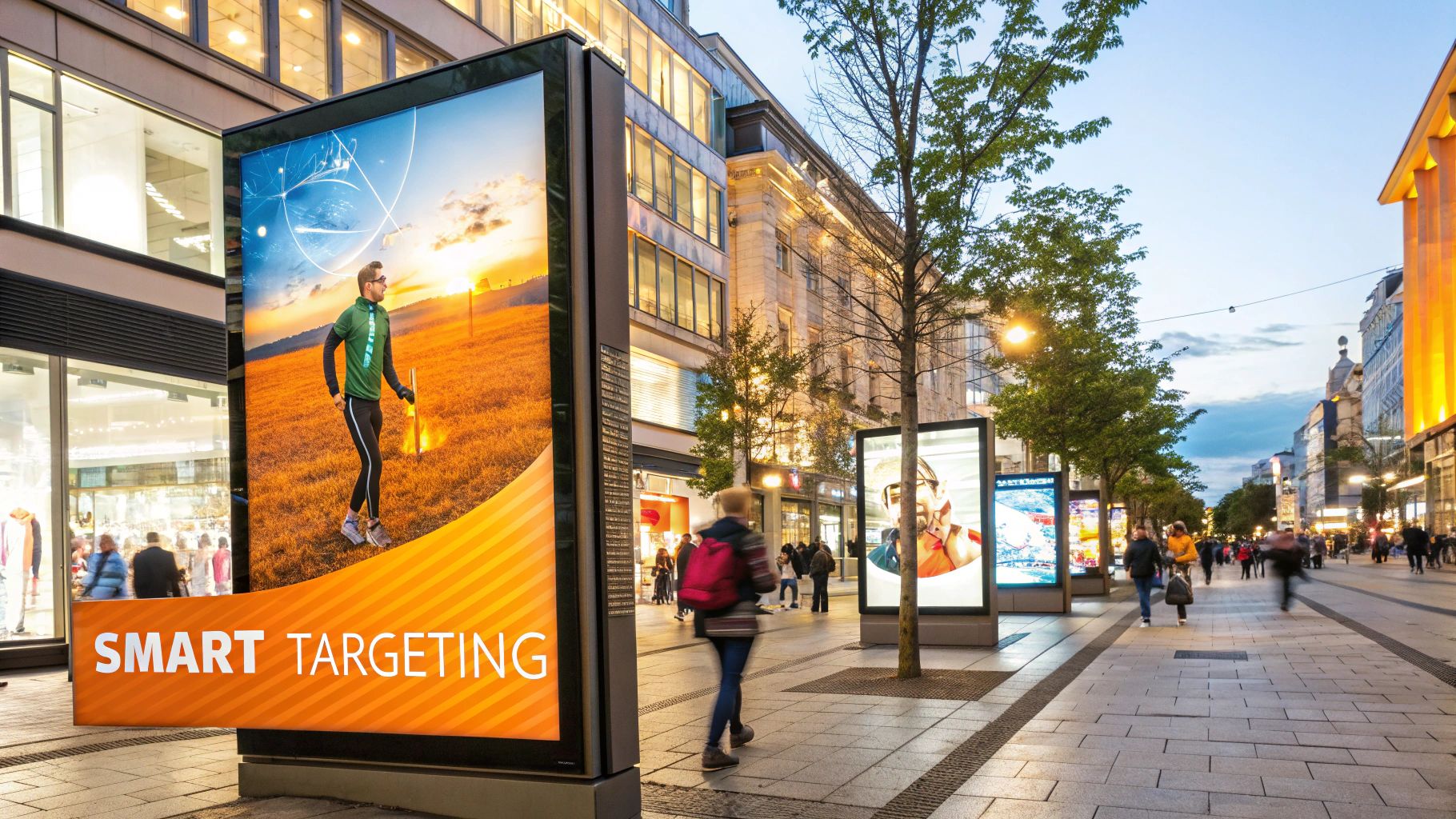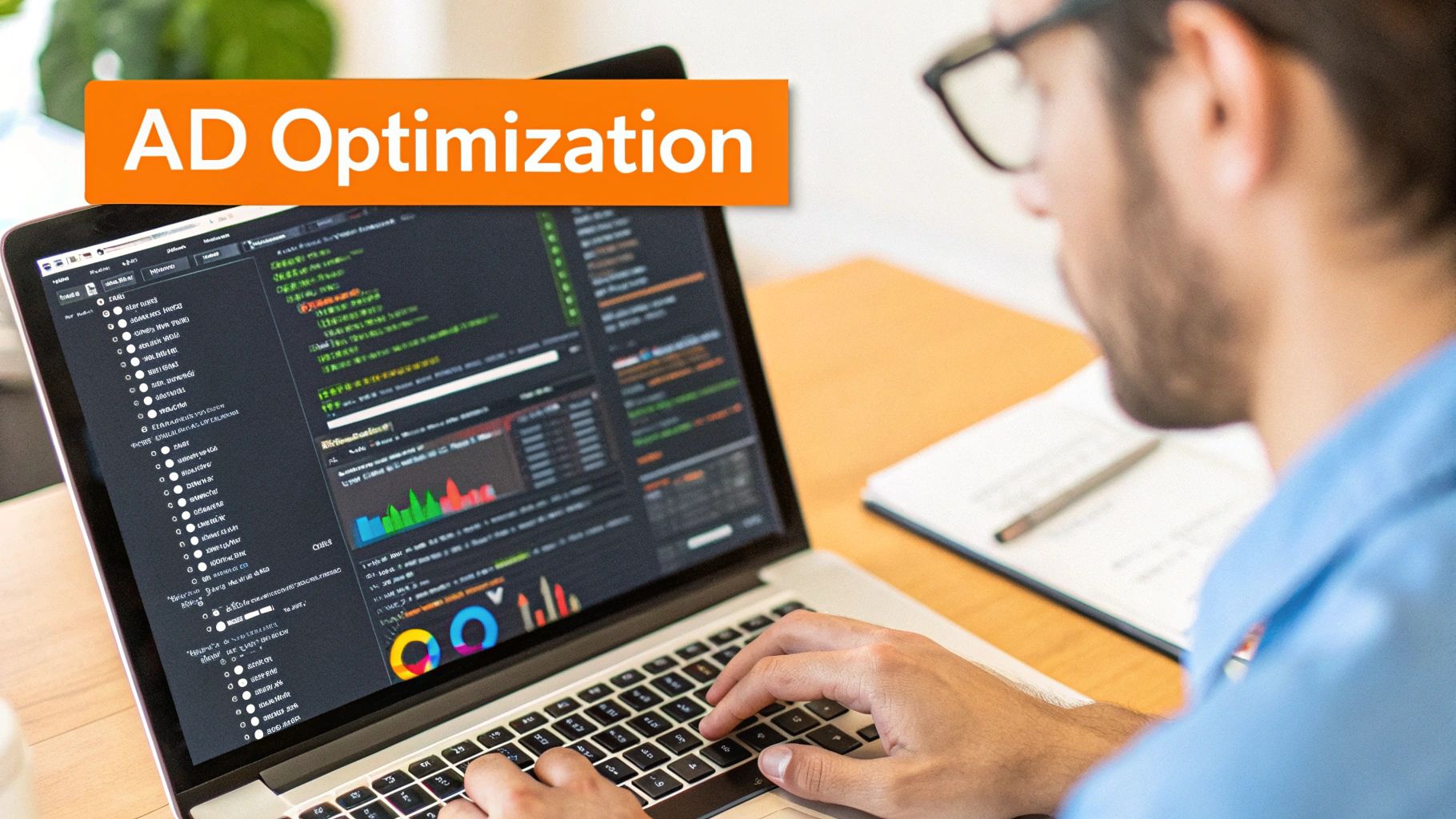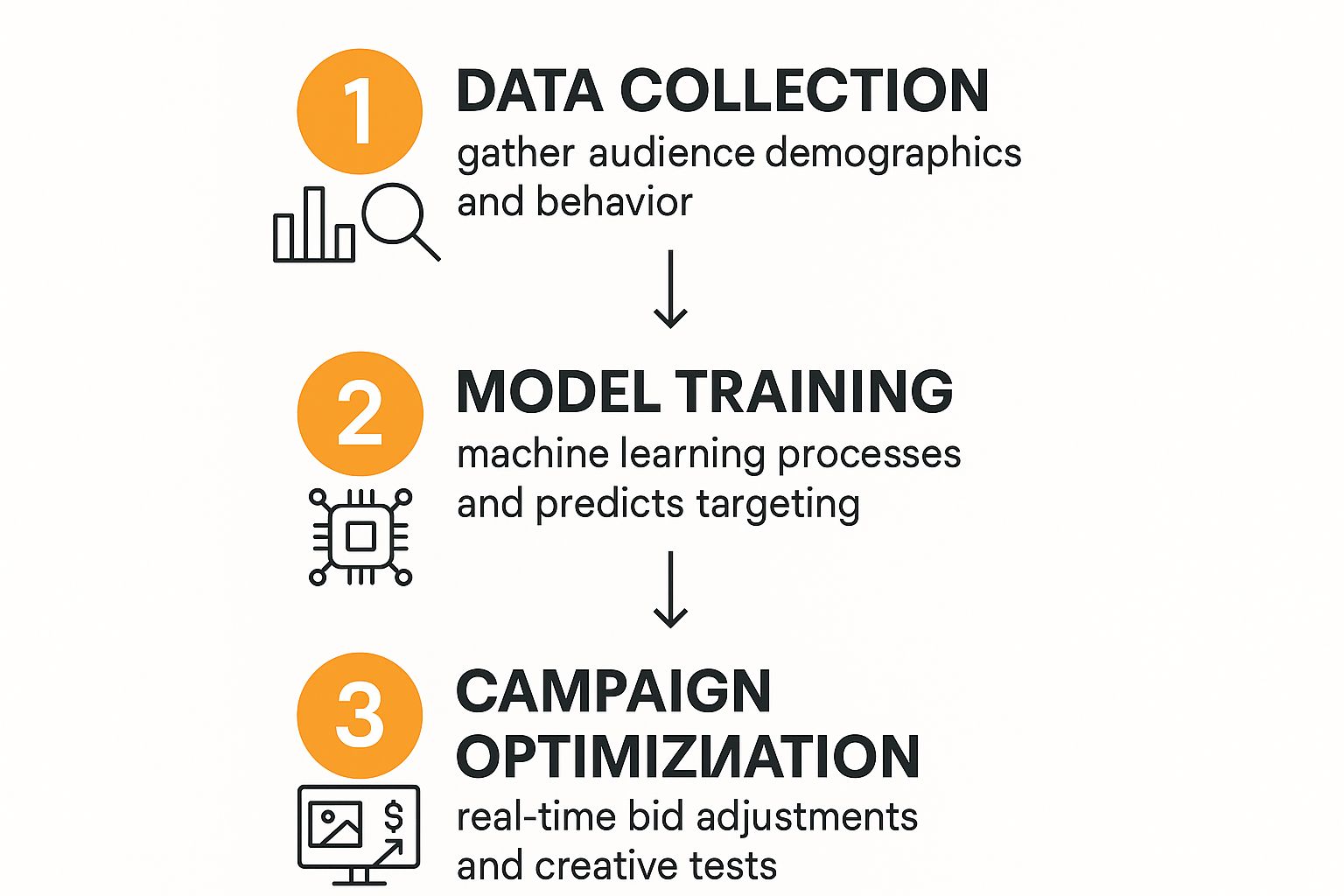Ai Powered Advertising: Transform Your Marketing Strategies

The Evolution of AI-Powered Advertising

Digital advertising has evolved significantly from its humble beginnings as simple banner ads. The integration of artificial intelligence (AI) is changing how marketers interact with their audiences and manage campaigns. This shift from static digital billboards to intelligent, personalized experiences represents a major leap in advertising effectiveness.
The driving force behind this evolution is the need to understand complex consumer signals, automate campaign decisions, and deliver truly personalized experiences at scale. This means leaving behind static campaigns and embracing dynamic, responsive strategies.
From Static to Smart: How AI Changed the Game
Early applications of AI in advertising focused on simple tasks like keyword bidding and basic targeting. However, progress in machine learning and data processing has unlocked exciting new possibilities.
For instance, AI now drives complex algorithms that analyze vast datasets to predict consumer behavior. This allows for more precise targeting and personalized messaging, resulting in higher engagement and conversion rates. AI also automates time-consuming tasks such as A/B testing and bid optimization, freeing up marketers to concentrate on strategic planning.
The Rise of Personalized Experiences and Automated Campaigns
The growth of AI-powered advertising is undeniable. The generative AI in advertising market, valued at approximately $2.72 billion in 2024, is projected to reach $3.39 billion in 2025. This represents a remarkable 24.6% compound annual growth rate (CAGR).
This impressive growth stems from the increasing importance of personalized and targeted advertising enabled by AI. The rise of social media platforms, content marketing, and programmatic advertising also contributes to this expansion. More detailed statistics can be found here: Generative AI in Advertising Global Market Report
This rapid expansion reflects the demand for more efficient and effective advertising solutions. AI’s ability to personalize ad experiences and automate campaign management makes it an essential tool for marketers. This data-driven approach presents opportunities for businesses to connect with consumers on a deeper level. Learn more about AI-powered advertising: AI-Powered Advertising on AD360
The Future of AI in Advertising: Continuous Optimization and Authentic Connections
The evolution of AI in advertising is a continuous journey. As AI technology progresses, we can anticipate even more sophisticated applications. These include improved personalization, more efficient campaign management, and innovative creative possibilities.
However, the core focus should remain on using AI to build genuine connections with consumers. This means providing valuable experiences and respecting user privacy. The future of AI-powered advertising lies in balancing data-driven optimization with authentic brand engagement.
Personalization That Actually Connects

Consumers today want marketing messages that truly speak to them. They’re more likely to engage with ads relevant to their individual needs and preferences. This is the foundation of personalized advertising. And AI-powered advertising elevates this concept, moving beyond basic demographics to create truly custom experiences.
This allows marketers to deliver the perfect message, to the right person, at the optimal time.
Understanding Consumer Behavior
AI has a unique ability to identify subtle patterns in consumer behavior, often unseen by human marketers. Think of it like this: AI algorithms analyze browsing history, purchase patterns, and even social media activity to craft detailed user profiles.
These profiles then help shape highly targeted advertising campaigns delivering relevant content and special offers. This level of detail significantly increases the chances of grabbing attention and boosting sales.
Balancing Personalization With Privacy
Personalization is powerful, but protecting user privacy is equally critical. Consumers are more aware of how their data is used and expect brands to be transparent and ethical. That’s why successful AI-powered advertising prioritizes giving users real value while respecting their privacy.
This means being open about how data is collected and offering users control over their information. The use of AI in marketing is growing quickly. By 2025, it’s estimated that 88% of marketers will incorporate AI tools into their daily work. This statistic highlights how AI-driven advertising has become essential to modern marketing strategies. You can find additional data here: AI Marketing Statistics.
The Difference Between Surface-Level and Deep Personalization
Many marketers confuse basic demographic targeting with true personalization. Simply using someone’s first name or mentioning their location doesn’t cut it. Real personalization requires a deeper understanding of a person’s needs and motivations.
AI unlocks this deeper understanding. It analyzes a vast amount of data to create a more complete picture of each consumer.
Context Is Key: AI’s Role in Understanding Consumer Intent
AI algorithms decipher the “why” behind a customer’s actions. This allows marketers to anticipate needs and deliver highly relevant ads. This could involve studying search queries, website visits, or even the time of day a user is online.
AI can then deliver ads that are not just personalized, but also helpful and well-timed. Rather than being intrusive, these ads enhance the user experience, fostering positive brand perception and building strong relationships.
To understand the impact of AI, let’s look at a comparison:
The following table showcases the improvements seen with AI-driven personalization.
Personalization Results Across Marketing Channels
| Marketing Channel | Traditional Approach Results | AI-Powered Approach Results | Improvement Percentage |
|---|---|---|---|
| Email Marketing | 10% Open Rate, 2% Click-Through Rate | 18% Open Rate, 5% Click-Through Rate | 80% Open Rate, 150% CTR |
| Social Media Ads | 0.8% Click-Through Rate, 0.5% Conversion Rate | 1.5% Click-Through Rate, 1.2% Conversion Rate | 87.5% CTR, 140% Conversion Rate |
| Display Advertising | 0.4% Click-Through Rate | 0.7% Click-Through Rate | 75% |
As the table shows, AI-powered personalization drives substantial improvements across different channels. This data underscores the power of AI in boosting engagement and conversions by offering tailored experiences.
Campaign Optimization That Eliminates Guesswork

Many marketers still base campaign planning and budget allocation on gut feelings and past performance. This can mean missed opportunities and wasted ad spend. But AI-powered advertising changes the game. It brings data-driven decisions to the table, maximizing campaign impact and getting the most out of every dollar. This empowers marketing teams to optimize performance and achieve better results.
How Machine Learning Algorithms Optimize Campaigns in Real Time
AI-powered advertising platforms rely on machine learning algorithms to constantly analyze campaign data. These algorithms find patterns and trends that humans might overlook. The result? Smarter budget allocation and more effective ad placement. Campaigns are optimized in real time, adapting to shifts in market conditions and consumer behavior.
For example, if an ad creative isn’t performing well, the AI can automatically adjust bids or even pause the ad. Machine learning can also predict which users are most likely to convert, helping marketers zero in on the best leads. This kind of real-time optimization just isn’t possible with traditional manual campaign management.
Practical Applications of AI-Powered Campaign Optimization
AI is already improving campaign performance in several key areas. Programmatic buying automates the process of purchasing ad space, ensuring ads appear on the most relevant websites and apps. This streamlines budget allocation and removes the need for manual negotiations.
Dynamic budget allocation automatically shifts budgets across different channels and campaigns to maximize ROI. If a campaign is performing exceptionally well, the AI increases its budget. If another campaign is lagging, the AI reduces its spend. This ensures marketing dollars always have the biggest impact.
Cross-channel optimization analyzes data from all marketing channels – search, social media, display, and more – to build a cohesive and effective strategy. By understanding how channels interact, marketers can adopt a truly integrated marketing approach. For example, the AI might identify users who interacted with a brand on social media and then show them personalized display ads to boost conversion rates.
Restructuring Marketing Workflows Around AI
As AI becomes more central to advertising, marketing teams are changing how they work. They’re redefining roles and learning new skills to use AI to its fullest. Marketers now need to interpret the data from AI platforms and use it to shape their strategies. They also need to be comfortable working with AI tools and collaborating with data scientists and other technical experts.
This collaboration between humans and AI creates a powerful combination. AI handles data analysis and automation, freeing up human marketers to focus on strategy, creative development, and building brand relationships. This partnership is crucial for success in the ever-changing world of AI-powered advertising. Ad360 provides an all-in-one platform for smarter advertising, using these AI-driven features to maximize ROAS and streamline campaign management across multiple channels. Learn more: Discover Ad360.
Creative Development That Breaks Through
Effective targeting is only half the battle in online advertising. Even the most precisely targeted ad campaign will fall flat if the creative doesn’t resonate with the target audience. This is where the power of Artificial Intelligence (AI) comes in, helping marketers create ads that truly connect. AI-powered advertising isn’t about replacing human creativity; it’s about amplifying it.
AI as a Creative Partner
Think of AI as a tireless assistant for your creative teams. Generative AI tools can create variations of ad copy, suggest compelling visuals, and even personalize ads based on individual user preferences. This frees up human creatives to focus on the bigger picture: developing compelling narratives, crafting unique brand voices, and ensuring the overall strategy aligns with core business goals.
This collaboration between human creativity and AI allows for more experimentation and iteration, leading to more innovative and impactful campaigns. The result? More effective ads that capture attention and drive results.
Systematic Creative Testing With AI
AI-powered advertising platforms provide robust testing frameworks. They go beyond simple A/B testing, allowing marketers to analyze multiple variations simultaneously and identify the highest-performing elements. Imagine testing different combinations of headlines, images, and calls to action all at once.
AI analyzes the results, highlighting the winning combinations and providing valuable insights. This allows teams to focus their energy on strategic innovation rather than tedious manual testing, ultimately leading to better campaign performance.
Maintaining Brand Consistency Across Platforms
Maintaining a consistent brand message across different platforms and audience segments can be challenging. AI can help maintain this consistency. By analyzing brand guidelines and historical data, AI tools can ensure that all creative variations stay true to the brand’s core identity.
This is particularly important for larger brands with complex messaging requirements. Consistent branding reinforces brand recognition and builds trust with consumers.
Tailoring Creative for the Customer Journey
AI helps tailor creative elements for different stages of the customer journey. A potential customer seeing an ad for the first time needs different messaging than a loyal customer already familiar with the brand.
AI can automatically adjust creative elements, such as visuals and ad copy, based on where the user is in their purchasing journey. This personalized approach leads to a more engaging and effective ad experience.
Measuring Creative Effectiveness and the Growth of AI
Ultimately, the success of any advertising campaign depends on whether it drives meaningful business outcomes. AI-powered advertising platforms provide detailed performance data, allowing marketers to track the effectiveness of their creative strategies and measure return on investment.
The global artificial intelligence market is expanding rapidly, currently valued at nearly $400 billion. By 2030, this figure is projected to reach $1.81 trillion, with a 35.9% CAGR. This growth underscores the increasing importance of AI across various industries, including advertising. For more insights, check out these statistics: Find more detailed statistics here. This data-driven approach ensures creative development remains aligned with business objectives.
Implementing AI Without Overwhelming Your Team
Successfully adopting AI-powered advertising requires a practical, step-by-step approach. This section offers a roadmap based on insights from organizations effectively using AI in their advertising strategies. We’ll cover key considerations, from data requirements to team training and vendor selection.
Assessing Your Current Capabilities
Before diving into AI, honestly evaluate your team’s current skills and resources. Do you have the data infrastructure to support AI-powered tools? Are your team members comfortable working with data-driven insights?
Identifying your starting point is crucial. If your team is new to data analysis, begin with simpler AI tools focused on specific tasks like keyword research or automated bidding. More experienced teams can explore advanced features such as predictive analytics and personalized creative generation. This ensures a smooth transition and maximizes the chances of success.
Building a Data-Driven Culture
AI thrives on data. To successfully implement AI-powered advertising, you need a robust data collection and management system. This doesn’t necessarily require enormous datasets, but it does mean collecting relevant, high-quality data.
Focus on gathering information that directly relates to your business objectives. This could include website analytics, customer demographics, and campaign performance data. This focused approach ensures your AI tools have the data they need to deliver meaningful results. Learn more in our article about bringing advertising AI to all.

This visualization shows the cyclical nature of AI-powered advertising. Data collection feeds into model training, which then optimizes campaigns and generates more data. This continuous feedback loop leads to ongoing improvement and increased efficiency.
Choosing the Right AI Advertising Partner
Selecting the right vendor is a critical step. Look beyond flashy demos and focus on vendors who understand your specific needs and offer robust support. Consider factors such as platform integration, data security, and reporting capabilities.
A good vendor will provide ongoing training and guidance to help your team effectively use their tools. They should also be transparent about how their AI algorithms work and how they protect user data. This helps build trust and ensures a successful partnership.
Empowering Your Team Through Training and Development
Introducing AI can create anxiety among team members. Address these concerns by providing comprehensive training and emphasizing how AI can enhance, not replace, their roles.
Focus on developing skills that complement AI capabilities, such as strategic thinking, creative problem-solving, and communication. This empowers your team to work alongside AI, using its insights to make more informed decisions.
Managing Expectations and Measuring Success
Set realistic expectations for AI implementation. It’s not a magic bullet; it takes time for AI algorithms to learn and optimize campaigns. Define clear success metrics and track progress regularly.
These metrics could include improved conversion rates, increased ROI, or reduced cost per acquisition. By monitoring these metrics, you can demonstrate the value of AI to stakeholders and ensure your AI strategy stays on track.
Adapting and Evolving With AI
The world of AI is constantly changing. Stay informed about new developments and be willing to adapt your strategy as needed. This could involve experimenting with new AI tools or adjusting your team’s workflows.
By embracing a culture of continuous learning and improvement, you can ensure your AI-powered advertising strategy remains effective and delivers long-term success. This flexible approach allows you to stay ahead of the curve and maximize the benefits of AI. You might be interested in: How to master AI in advertising.
The following table provides a structured approach to implementing AI-powered advertising, outlining key stages, activities, and expected outcomes.
AI Advertising Implementation Roadmap
| Implementation Phase | Key Activities | Required Resources | Expected Outcomes | Timeline |
|---|---|---|---|---|
| Assessment | Audit existing skills, resources, and data infrastructure. | Team members, data analysis tools | Clear understanding of current capabilities and areas for improvement. | 1-2 weeks |
| Data Foundation | Implement data collection and management systems. | Data engineers, analytics platform (Google Analytics) | Robust data pipeline for AI tools. | 2-4 weeks |
| Tool Selection | Evaluate and select AI advertising tools and vendors. | Vendor research, budget allocation | Chosen tools aligned with business needs and team capabilities. | 2-4 weeks |
| Team Training | Provide comprehensive training on AI tools and related skills. | Training materials, vendor support | Team proficiency in using AI tools and interpreting data insights. | 4-6 weeks |
| Implementation & Measurement | Launch AI-powered campaigns and track key performance indicators. | AI advertising platform, reporting tools | Improved campaign performance, data-driven optimization. | Ongoing |
| Refinement & Adaptation | Continuously monitor, analyze, and adapt strategy based on results and new AI developments. | Performance data, industry research | Long-term success and maximized ROI from AI advertising. | Ongoing |
This roadmap helps break down the implementation process into manageable phases, allowing for a more controlled and successful integration of AI into your advertising efforts.
Future-Proofing Your AI Advertising Strategy
AI capabilities are constantly changing. This raises an important question: how can you create an advertising strategy that remains effective over time? By analyzing emerging trends and using practical evaluation methods, we can prepare for the future of AI in advertising. This means understanding which new applications offer real value and which are simply overhyped.
Navigating the Evolving AI Landscape
Marketing leaders and technology experts are always exploring new AI applications. Some, like predictive analytics and real-time bidding optimization, hold significant promise. Others might not live up to the hype. It’s crucial to separate genuine progress from temporary fads. A practical evaluation framework is essential for assessing new AI capabilities.
This framework should consider factors like data requirements, how complex it is to implement, and the potential return on investment. By thoroughly evaluating new technologies, you can avoid wasting resources on unproven solutions and concentrate on those most likely to deliver results.
Building Adaptable Strategies for Long-Term Success
Successful companies aren’t just adopting individual AI tools; they’re developing adaptable strategies. These strategies integrate new technologies while maintaining consistent brand experiences. Think of your AI advertising strategy as a living document, constantly adapting to reflect the latest developments.
This means staying informed about emerging trends and being ready to adjust your approach as needed. This flexibility is essential for staying competitive in the ever-changing world of AI-driven advertising.
Ethical Considerations in AI-Powered Advertising
As AI plays a bigger role in advertising, ethical considerations become increasingly vital. Transparency is paramount. Consumers deserve to know how AI is used to target them with ads. Building trust, not damaging it, is crucial.
Openly communicating how you use AI can strengthen customer relationships. Hiding these practices, on the other hand, can hurt your brand’s reputation. Transparency builds confidence and cultivates a positive brand image.
The Impact of Regulation on AI Advertising
The regulatory environment around AI is constantly evolving. New laws and guidelines are emerging that address data privacy and algorithmic bias. Staying up-to-date on these developments is essential.
These regulations can have a major impact on your AI advertising strategy. Ignoring them could lead to legal problems and damage your reputation. By understanding and following regulations, you can ensure your campaigns are both ethical and effective. Learn more in our article about unlocking ad precision with programmatic.
Ad360: Your Partner in Future-Proofing Your Advertising
Ad360 provides a comprehensive platform for AI-powered advertising, helping businesses navigate the complexities of this dynamic landscape. With Ad360, you can centralize your media buying, optimize campaigns in real time, and use advanced AI features to maximize your ROAS.
Discover how Ad360 can help you build a future-proof AI advertising strategy.